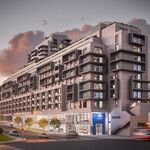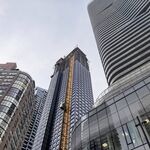TOareaFan
Superstar
The point of being at Queen and Main is that this location is served by GO train, GO bus, and 2 Zum bus routes. If more service were added to the GO train line then it would be very easy to reverse commute from Toronto. Meanwhile Mississauga Rd and 407 is served by lousy bus service, Highway 407 and 401, the vast majority of people will drive.
Since people will commute from all over the GTA to get to jobs a location with poor transit like this is problematic. Also Highway 407 has expensive tolls so many drivers use free parallel routes like 401, Derry, and Steeles which get congested in both directions in rush hour. If you are coming from Toronto you have no choice but to use 401 or Gardiner which is congested both ways. The traffic in Mississauga, which has far more office parks like this than Brampton is horrible in rush hour because of this. Plus it is shortsighted for an employer to not think about the effects of moving their headquarters a long distance (Yonge and St. Clair to Mississauga Rd and 407 can take 1+ hours by car due to traffic congestion).
There needs to be a provincial law providing significant tax credits for employment near major transit routes, and/or banning office parks with bad transit service entirely.
A reverse commute to Brampton by GO Transit is tough...so I am not sure how many that previously worked at Yonge & St. Clair and had their jobs moved to Brampton would do it even if the office was at Queen and Main......but, are you suggesting (under current rules) Brampton should have said to Orlando..."geez, thanks for attempting to bring the head office of such a large company to town and thanks for the potential of decent white collar jobs but, really, if you're not willing to locate them at Queen and Main, we do not want them and we will not issue building permits?" How would that go over at the OMB? Or should they accept that having these jobs improves the situation in Brampton, accept that not all office jobs can be in one designated location, accept taht the nature of their business (having stores all over the place to visit) makes highway access important to the company and, then, adjust their own transit system to provide a route that goes to/from the location (after all, that is all that they control transitwise). Should Mississauga have turned down the jobs that Orlando developments brought to their city because they were not on GO lines?
You're last notion of Provincial legislation is interesting (not sure how it would work) but the post I responded to singled out Brampton as a needing to "start making use of their major transport infrastructure" relative to other suburban nodes/cities. If that is the case, I am still not hearing an explanation of how they are not doing that, what infrastructure they have that they are wasting and what they could be doing better.
I think the biggest lesson we should learn from Brampton is that before you designate a place as a place to grow, before you encourage and allow municipality to grow to over half a million people....before all of that you need to figure out infrastructure at the provincial level....you need to figure out how to get all day two way transit there....and/or provide more than 3 lanes each way on one road of provincial highway to connect to the 400 series roads....and provide more than 400 hospital beds.
If Brampton is anything, it is a failure of the Province (in a very bi-partisan comment here as parties of all stripes have sat and encouraged/watched this happen) to recognize that having such a large group of people in one place without needed infrastructure is not a good thing......and, perhaps, it should be a learned lesson to apply to other places (whilst also playing catch up in Brampton
What comes first? Brampton's population reaching 600k or all day GO train service? What comes first? Brampton's population reaching 600k or their 600th hospital bed?
It is fine for the province to designate somewhere a "place to grow" but there has to be more to smart growth than just jamming more people int the same space (although that is part of it) or you lose the support of people for the growth. If you ran a plebiscite in Brampton and asked "what is the right number of new peole to allow/push into Brampton with the current infrastructure" (or words to that effect as I just rambled that question off as I typed) not only would you get no support for more population (no matter how densely/smartly they were located) you would likely get a lot of write in votes for negative population growth.....it is a mess out there and I think, wrongly, people outside point to easily at our municipal polititicians (who are not blameless) without looking at a much bigger picture.




